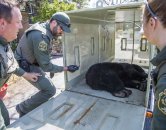Source Feed: National Post
Author: Chris Lambie
Publication Date: May 9, 2025 - 19:48
Royal Canadian Navy ship takes 'amazing' four month voyage to Antarctica and back
May 9, 2025

The Royal Canadian Navy returned to Halifax Friday from a deployment to Antarctica with tales of spotting exotic wildlife and samples that could lead to a greater understanding of climate change.
HMCS Margaret Brooke’s four-month voyage took the Arctic and offshore patrol ship to South America and beyond, logging close to 25,000 nautical miles, or 46,300 kilometres.
“It’s been just such an amazing experience to visit an area of the world where less than one per cent of the world’s population has visited,” said Cmdr. Teri Share, the skipper of Margaret Brooke.
The Arctic and offshore patrol vessel was the navy’s first ship to be north of the Arctic Circle and south of the Antarctic Circle all within the same year.
“Not only were we able to do all this amazing work with science in the south, within Antartica, but the relationships that we built with Latin American countries on the way south and north was just phenomenal,” Share said. “It’s in an area where the RCN hasn’t been able to really operate in the last couple of decades. So, it’s been amazing to be able to help build those relationships again.”
The ship, crewed by 83 people, carried both sailors and scientists.
“We traveled to the South Shetland Islands and then along the Antarctic Peninsula collecting a lot of sea floor data and water column data to understand the effect of climate change on retreating glaciers,” said Alex Normandeau, a research scientist from Natural Resources Canada who made the trip with Margaret Brooke.
He was one of 15 federal government and university scientists aboard.
One of their tasks was to learn more about how glaciers are retreating.
“Some of the things we were looking at (are) where glaciers were positioned, for example, 50 or 100 years ago and how fast that retreat happened, and to do that we collect some sediment cores to go back in time,” Normandeau said.
Scientists plan to start analyzing those samples at the Bedford Institute of Oceanography next week.
“When we open those cores and look at the different layers that we see in there, that’s when we’ll have a better story to tell about climate change,” said the marine geologist.
“We hope to learn about the rate of glacier retreat related to climate change over the years and how that has evolved through time. So, has it been increasing over the last 10 years or the last 20 years?”
The crew spotted “massive amounts of wildlife” during the voyage including three or four different types of penguins in Antarctica, said the ship’s captain.
“One actually hopped in one of our small boats and ended up spending a little time in there,” Share said. “They’re everywhere down there; they’re beautiful.”
They also spotted several different types of whales, seals and sea birds.
Percy the Penguin signing up for the Naval Experience Program aboard HMCS Margaret Brooke. Video courtesy of Chris LandryPosted by Royal Canadian Navy Today and Yesterday on Thursday, March 13, 2025The Antarctic looks like Canada’s Western Arctic, with mountains and glaciers, Share said. “So, we felt like home almost at some points.” The trip aboard Margaret Brooke “was the first large-scale expedition for science like this,” Normandeau said. “This was really showing how we can work with the navy,” he said. “It also shows that we can do that type of work in other environments, like the Arctic, in the future from these vessels.” Margaret Brooke steamed through half-metre thick ice in Antarctica. “Now this crew can say we have some pretty significant experience doing ice breaking,” Share said. Her ship also navigated amongst icebergs. “That’s another check in the box for us.” It didn’t take long for the sailors in uniform to get used to having scientists aboard in civvies, Share said. “Within a couple of days, I think we were a well-oiled machine.” The deployment took Margaret Brooke first to the Caribbean, then South America, where federal government scientists came aboard in Punta Arenas, Chile, for the voyage south of the Antarctic Circle to the northern tip of Antarctica. During the scientific portion of the trip, “we had every single small boat on the ship out … collecting samples,” Share said. “We had uncrewed surface vessels. We had scientists ashore. We just did everything and anything to support them, and that’s all things that we can help do in the north as well.” To reach Antarctica, they had to cross the notoriously rough Drake Passage, which connects the Atlantic and Pacific oceans between Cape Horn and the South Shetland Islands. The trip south “was very calm seas,” Share said. The return trip wasn’t so pleasant, with the Margaret Brooke battling six-metre waves as it headed back north. “We ended up getting a bit of an experience on the way back home,” Share said. “But … these ships are meant for the North Atlantic, they’re meant for the Arctic, they’re meant for our weather up here. So, it’s nothing that we couldn’t handle … Not too many people got sick.” The ship performed “amazingly,” she said. “We really didn’t have any major technical difficulties that impacted our mission at all,” Share said. “So, this definitely has proven that we are incredibly versatile with this platform to operate in a very warm climate in and around the equator for a little bit, and all the way down into polar regions and back up.”
HMCS MARGARET BROOKE hoisting their battle ensign while entering Halifax after a historic deployment to Antarctica. The ship reached the farthest south a RCN ship has ever deployed, proving their versatility and value to the RCN and Canada. Bravo Zulu!Posted by Royal Canadian Navy Today and Yesterday on Friday, May 9, 2025Our website is the place for the latest breaking news, exclusive scoops, longreads and provocative commentary. Please bookmark nationalpost.com and sign up for our daily newsletter, Posted, here.
A young bear was taken from Kanata North last month and dumped 200 km away, at a site chosen by the Ontario Ministry of Natural Resources, in a Wildlife Management Unit where the spring bear hunt is underway. The incident exposes the failure of the City of Ottawa's Wildlife Strategy. Read More
May 10, 2025 - 04:00 | Christina Spencer, Ottawa Citizen | Ottawa Citizen
After more than a decade in the same location, Ottawa entrepreneur Jamie Mcleod was delighted to secure a new home in the ByWard Market for her vintage clothing shop. Read More
May 10, 2025 - 04:00 | Lynn Saxberg | Ottawa Citizen
A new dock at Dows Lake opened on May 8, offering Ottawans a new way to connect with the water, and maybe, eventually, go for a swim. Read More
May 10, 2025 - 04:00 | Robert Hiltz | Ottawa Citizen




Comments
Be the first to comment